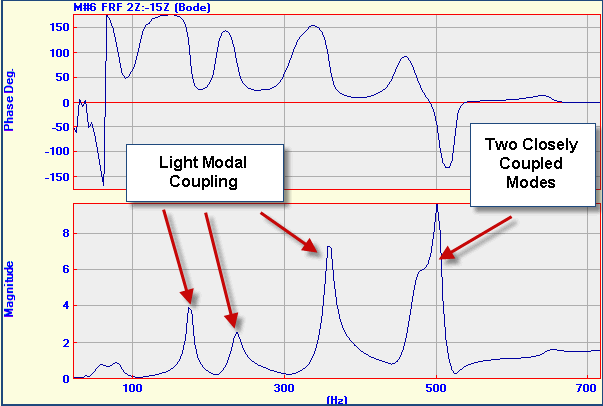
If the resonance peaks in a set of FRFs are widely separated, these modes are called lightly coupled modes.
When modes are lightly coupled, a Single-Degree-Of-Freedom (SDOF) method can be used to estimate modal parameters one mode at a time without incurring significant errors.
SDOF methods are used to quickly obtain mode shape estimates with a minimum of user interaction.

Light and Heavily Coupled Modes
The Peak method is an SDOF method that saves the Peak value of the displayed FRF data in a band surrounding each modal frequency as the residue. The Peak method is useful when resonance peaks shift slightly from one FRF to another, due to non-stationary effects.
If the Imaginary part of the FRF is displayed, the Peak value of the Imaginary part from each FRF is used as the residue for each mode.
If the Real part of the FRF is displayed, the Peak value of the Real part from each FRF is used as the residue for each mode.
If neither the Real nor the Imaginary part of the FRF is displayed, the Real & Imaginary parts from each FRF at the Peak value of its magnitude is used as the residue for each mode.
If the resonance peaks in a set of FRFs are closely spaced, these modes are called closely coupled modes.
A Multi-Degree-Of-Freedom (MDOF) method should be used to simultaneously estimate the modal parameters of closely coupled modes.
The Polynomial method is a Multi-Degree-Of-Freedom (MDOF) method that uses all of the complex (real & imaginary) FRF data, or the data in the cursor band if it is displayed.
During residue curve fitting, the numerator polynomial of each FRF is estimated by a least squared error curve fitting process. The denominator polynomial is constructed using the frequency & damping of all (or selected) modes in the Modal Parameters spreadsheet.
The residue for each mode and each FRF is obtained by performing a partial fraction expansion of each rational fraction polynomial, following the curve fitting process.
The residual effects of out-of-band modes are compensated for by the use of additional numerator polynomial terms during Polynomial curve fitting.
Both the Frequency & Damping and Residue curve fitting methods use the extra polynomial terms to account for the residual effects of out-of-band modes.
The number of extra polynomial terms used is specified on the Frequency & Damping tab.